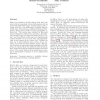Free Online Productivity Tools
i2Speak
i2Symbol
i2OCR
iTex2Img
iWeb2Print
iWeb2Shot
i2Type
iPdf2Split
iPdf2Merge
i2Bopomofo
i2Arabic
i2Style
i2Image
i2PDF
iLatex2Rtf
Sci2ools
AUIC
2003
IEEE
2003
IEEE
Get a Way Back: Evaluating Retrieval from History Lists
Many user interfaces include history lists that help users retrieve temporally ordered information such as previously visited web pages, email messages, and recently used files. Two main types of history lists are widely used. The first type, typified by Netscape Navigator’s history list, provides a linear temporally ordered list. The second type, typified by Microsoft Internet Explorer’s history list, provides a hierarchical structure based on temporal chucks such as “Today” and “Last Week” at the top level, alphabetically ordered websites at the second level, and alphabetically ordered pages at the lowest level. Despite the wide use of these different types of list, we are unaware of research into their relative merits. This paper describes an experiment that investigates the efficiency of retrieval from four different types of history lists, derived from the two main alternatives described above. The results indicate that simple linear ordering of information is s...
| Added | 04 Jul 2010 |
| Updated | 04 Jul 2010 |
| Type | Conference |
| Year | 2003 |
| Where | AUIC |
| Authors | Michael Jasonsmith, Andy Cockburn |
Comments (0)

